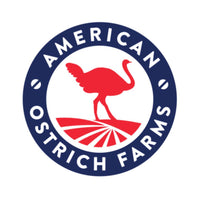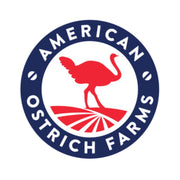Ostrich meat is an increasingly popular alternative to traditional meats like beef, pork, and chicken. It is a lean and protein-rich meat that offers a number of health benefits, especially for those who may have been advised by their physician to reduce their red meat consumption to manage their weight, cholesterol, or other health risks. Ostrich is both a true red meat -- similar in taste, texture, and composition to grass-fed beef, bison, and elk -- as well as poultry. This seemingly paradoxical fact is what makes ostrich meat an exceptionally healthy, easy-to-digest, non-mammalian protein. Learn why ostrich can be considered a red meat superfood.
FLAVOR WITHOUT THE (BAD) FAT
Ostrich meat is low in fat, especially saturated fat, which makes it a healthier choice than other meats. The majority of the fat it does contain are the 'good fats', which are mono- and polyunsaturated. Of the three total grams of fat in a serving of our ground ostrich, for instance, approximately two grams are good fats.
Monounsaturated fat is liquid at room temperature and is found in foods like olive oil, avocado, and nuts. Monounsaturated fats can help improve cholesterol levels and reduce the risk of heart disease. Polyunsaturated fat is also liquid at room temperature and is found in foods like salmon, tuna, walnuts, and flaxseeds. Polyunsaturated fats include omega-3 and omega-6 fatty acids, which are essential for good health. Omega-3 fatty acids can help lower triglycerides and reduce the risk of heart disease.
Saturated fat, meanwhile, is typically solid at room temperature and is commonly found in animal products like meat, butter, cheese, and cream. Saturated fat has been linked to increased risk of heart disease and high blood cholesterol levels, so it's generally recommended to limit one's intake. Our ground ostrich contains only one gram of saturated fat per 1/4-pound (4oz) serving, as compared to six grams in ground grass-fed beef, almost four grams in ground elk, and two grams in ground turkey.

Trans fat, which is not present in significant amounts in ostrich meat, is particularly harmful because it raises LDL (bad) cholesterol and lowers HDL (good) cholesterol, increasing the risk of heart disease.
Reducing intake of saturated and trans fats while increasing intake of monounsaturated and polyunsaturated fats can help improve cholesterol levels and reduce the risk of heart disease, which makes ostrich meat a no-brainer. In fact, ostrich is the only red meat recommended by the British Heart Association and the American Diabetes Association.
You may be thinking, "But fat is flavor." While this is certainly true of mammalian meats like beef, pork, and lamb, the resolutely red meat flavor of ostrich is in the meat itself. That's one of the reasons you can chow down on a big juicy ostrich burger without feeling bloated or groggy afterwards.
What about cholesterol? Although not technically a type of fat, cholesterol is often included in discussions of dietary fat and can be found in animal products like meat, eggs, and dairy. High levels of dietary cholesterol can raise blood cholesterol levels and increase the risk of heart disease, so it's generally recommended to limit intake. American Ostrich Farms' ground ostrich has only 65mg per serving, less than the 70mg in grass-fed beef, 66mg in elk, and 69mg in ground turkey.
A HIGH-QUALITY PROTEIN
At 25 grams of protein per serving depending on the particular cut -- which can be upwards of 50% of the recommended daily amount based on your dietary needs -- ostrich is an excellent source of the macronutrient essential for building and repairing tissues in the body. In fact, ostrich contains more protein per pound than beef.
While all meat, including poultry and fish, is a rich source of protein, not all animal proteins are created equal and different sources have different amino acid profiles and different biological effects. The exact amino acid profile of ostrich meat may vary slightly depending on factors such as the age, diet, and physical activity of the animal, as well as the cooking method used. However, in general, ostrich meat is a good source of high-quality protein with a well-balanced amino acid profile that contains all nine essential amino acids that the body cannot produce on its own and must obtain through the diet.
Approximate Amino Acid Profile of Ostrich Meat (per 100 grams)
|
|
|
*Source: E A Rogozina, et al (2021)
PUMP UP THE IRON
Iron is an essential mineral that is important for the production of red blood cells, healthy immune function, and maintaining cognition. The human body typically absorbs iron from animal sources more easily than from plant sources. While all red meats are a good source of iron, ostrich meat is an especially good source. Our ground ostrich contains nearly three times as much iron as grass-fed ground beef. Each 4oz serving has more than 35% of the recommended daily amount.
|
Iron Content Per 100 Grams |
 |
The rich iron content of ostrich meat makes it highly appealing to children, whose bodies require more of the mineral than most adults because of their rapid growth and development. Kids who have eaten ostrich often crave it, and considering the meat's multitude of other health benefits, parents are often relieved to find a healthy protein picky eaters will readily devour.
NUTRIENT DENSE RED MEAT
Sure, ostrich is a red meat and it probably makes sense that it's packed with protein and iron. So what qualifies it as a superfood? Compared to many other meats, ostrich is a better source of vitamins and minerals.
-
Zinc: A 100-gram serving of cooked ostrich meat provides around 4 milligrams of zinc, over 30% of the recommended daily value. Zinc is an important mineral that is involved in many bodily processes, including immune function, wound healing, and DNA synthesis.
-
Vitamin B12: A 100-gram serving of cooked ostrich meat provides around 5 micrograms of vitamin B12, a whopping 207% of the recommended daily value. Vitamin B12 is important for the production of red blood cells and the maintenance of a healthy nervous system.
-
Niacin: A 100-gram serving of cooked ostrich meat provides around 5 milligrams of niacin, 30% of the recommended daily value. Niacin is a B vitamin that is important for energy production and the maintenance of healthy skin, nerves, and digestion.
-
Phosphorus: A 100-gram serving of cooked ostrich meat provides around 210 milligrams of phosphorus, roughly 20% of the recommended daily value. Phosphorus is important for the formation of healthy bones and teeth, as well as for the production of energy in the body.
- Selenium: A 100-gram serving of cooked ostrich meat provides around 35 grams of selenium, 63% of the recommended daily value. Selenium plays several important roles in the body, including antioxidant synthesis, proper thyroid function, immune system regulation, DNA production, and reproductive health.

With the exception of Folate (Vitamin B9), ostrich meat is a good source of all the other B vitamins. In general, B vitamins are essential for maintaining good health and preventing deficiency-related diseases.
-
Thiamine (B1): Thiamine is important for the metabolism of carbohydrates, which provide energy for the body. It also helps maintain healthy nerves, muscles, and heart.
-
Riboflavin (B2): Riboflavin is important for the metabolism of fat, carbohydrates, and proteins, which provide energy for the body. It also helps maintain healthy skin, eyes, and nervous system.
-
Pantothenic acid (B5): Pantothenic acid is important for the metabolism of carbohydrates, fats, and proteins. It also plays a role in the production of hormones.
-
Pyridoxine (B6): Pyridoxine is important for the metabolism of amino acids, which are the building blocks of protein. It also helps maintain healthy nerves, skin, and red blood cells.
EASY ON THE STOMACH
Compared to other red meats, ostrich is considered much easier to digest. This is because it's one of the few red meats from a non-mammalian source. The digestibility of ostrich is due in part to its low fat content. Fat takes longer to break down than other substances and this can lead to feelings of over-fullness and discomfort. Like other forms of poultry or fowl, ostrich meat has smaller muscle fibers and less connective tissue than beef or pork. Smaller fibers and minimal connective tissue require less work for the digestive system to break down.
Like other types of meat, ostrich meat contains various enzymes that help with its digestion.
-
Protease: Protease is an enzyme that helps break down proteins into smaller molecules that can be more easily absorbed by the body.
-
Lipase: Lipase is an enzyme that helps break down fats into smaller molecules. While ostrich meat is much leaner than beef or pork, it still contains some fat, and lipase may help with its digestion.
-
Amylase: Amylase is an enzyme that helps break down carbohydrates into simpler sugars. While meat is not a significant source of carbohydrates, amylase can help with digestion more generally.
As a non-mammalian red meat with a flavor profile similar to that of grass-fed beef or elk, ostrich is a great choice for anyone who enjoys eating steaks or burgers, but tends to avoid mammalian proteins like beef and pork because they are harder to digest. In fact, ostrich meat can be a godsend for individuals with an allergy to more traditional red meats; after developing alpha-gal syndrome -- a condition transmitted by the bite of Lone Star ticks that triggers an allergic reaction to a sugar molecule found in most mammalian meats -- a person may find that ostrich is the only red meat they can consume without becoming ill.
THE BOTTOM LINE
Overall, ostrich meat is a healthy choice for people looking to reduce their intake of saturated fat and cholesterol while still enjoying a high-quality protein source that looks, cooks, and tastes like premium grass fed beef or elk.
Check out the nutrition facts for our ground ostrich steak.







